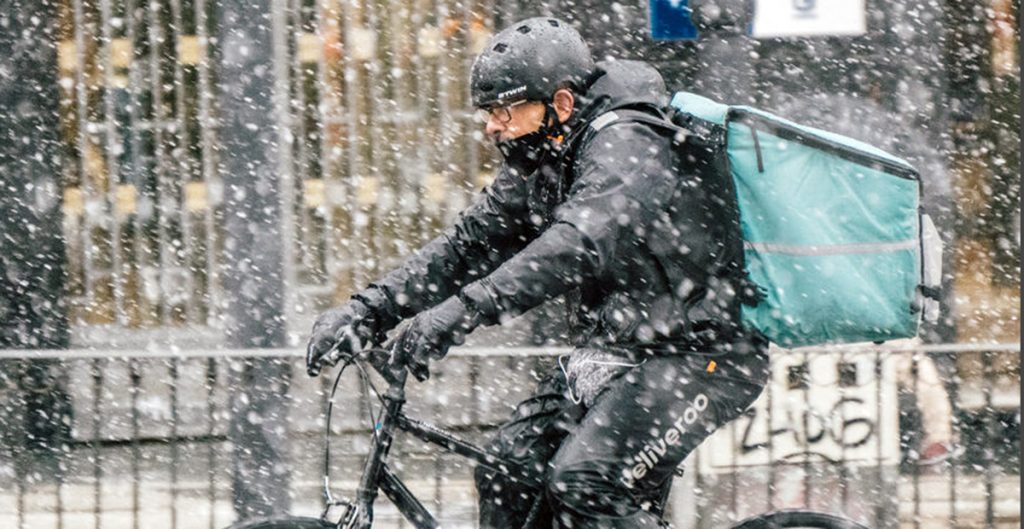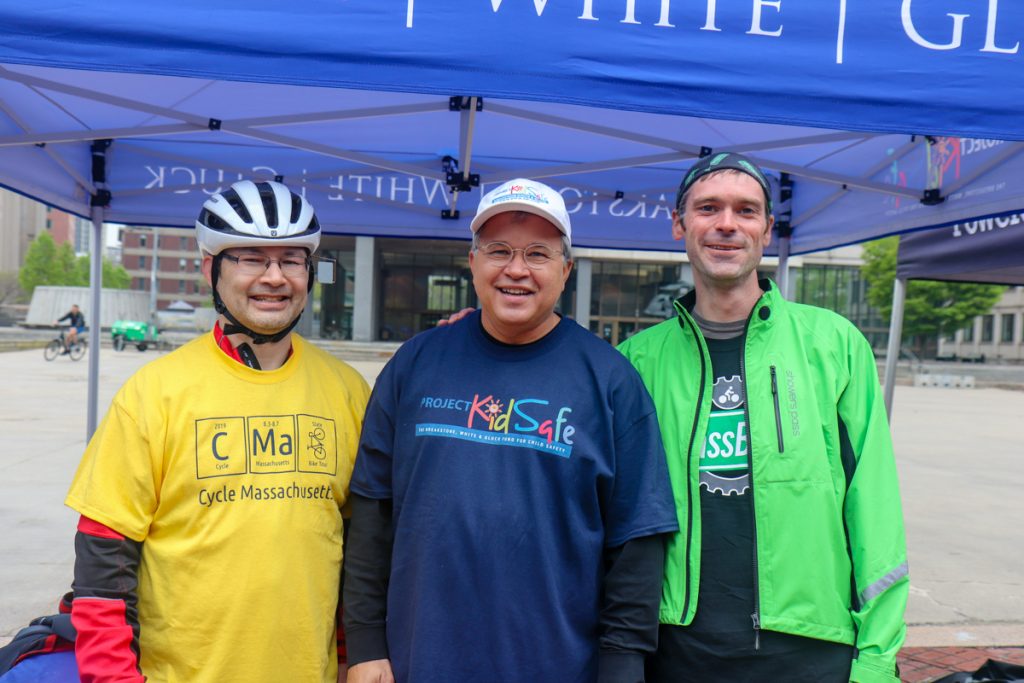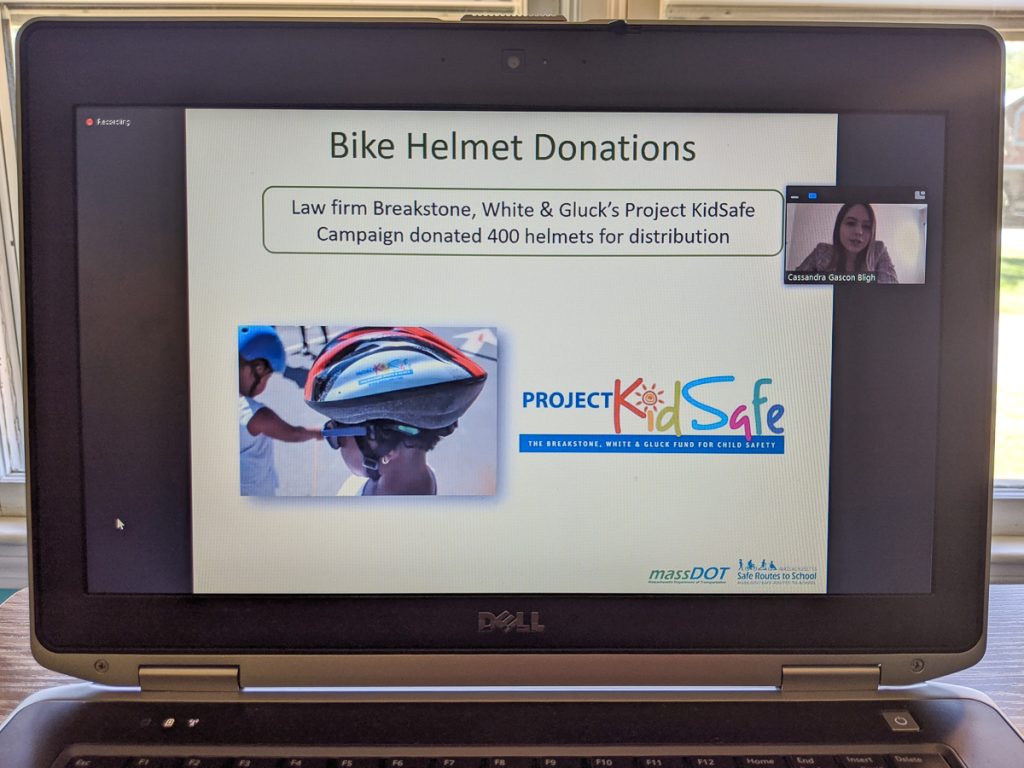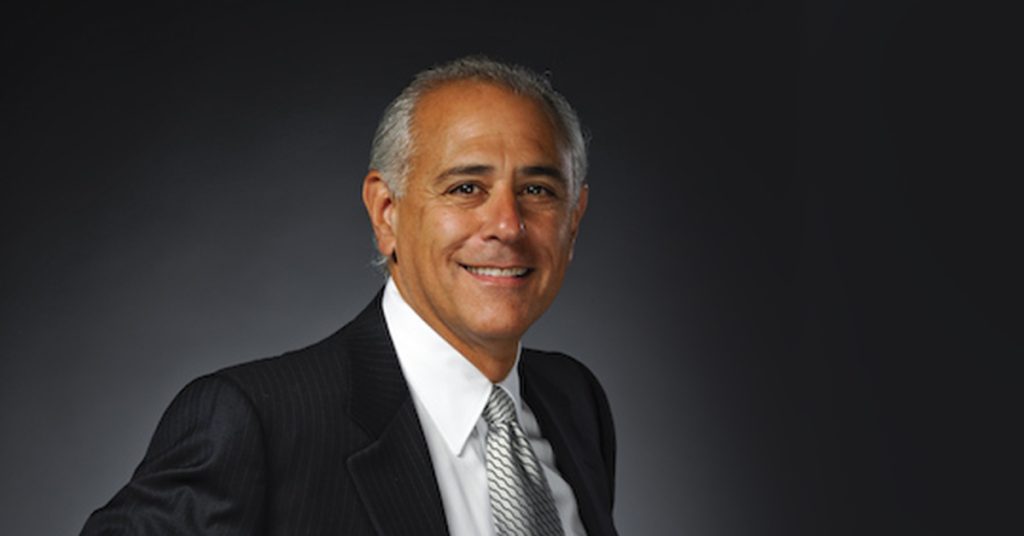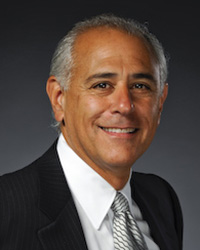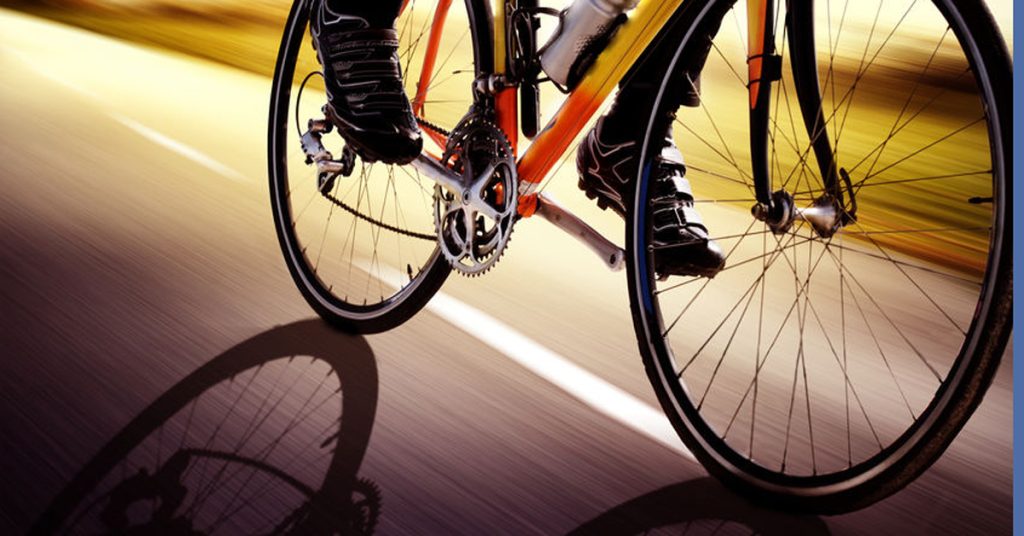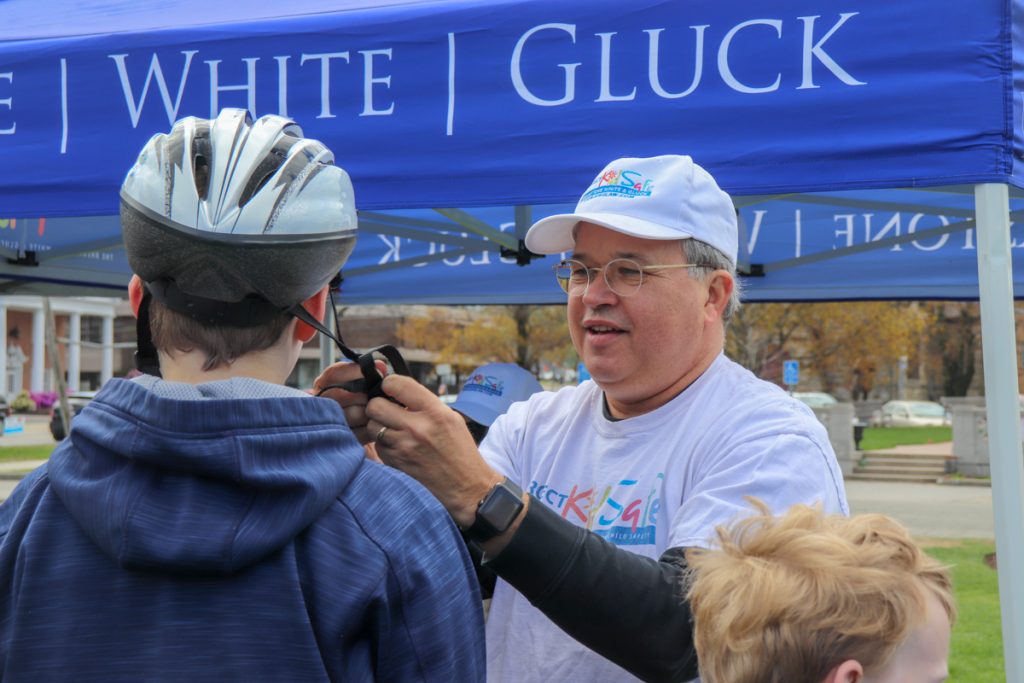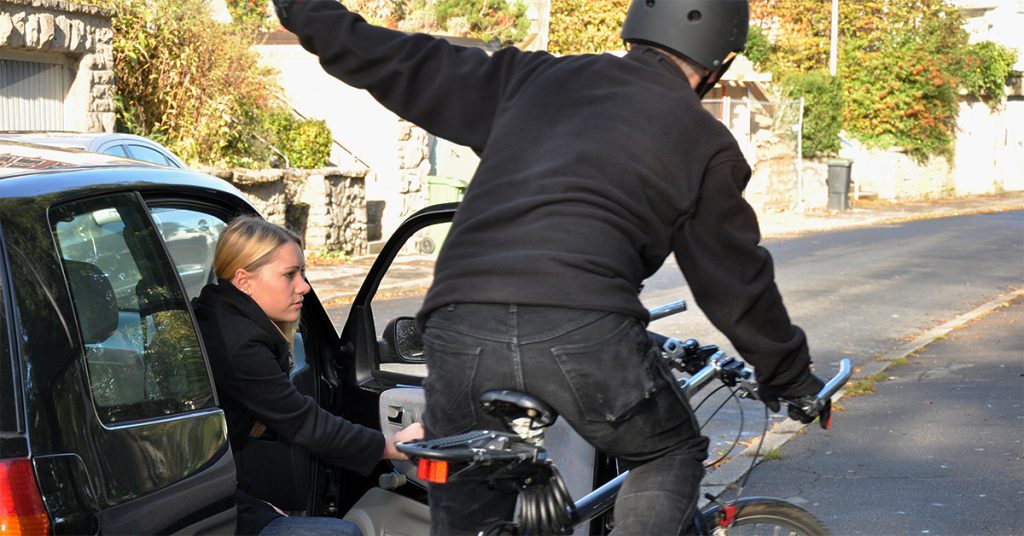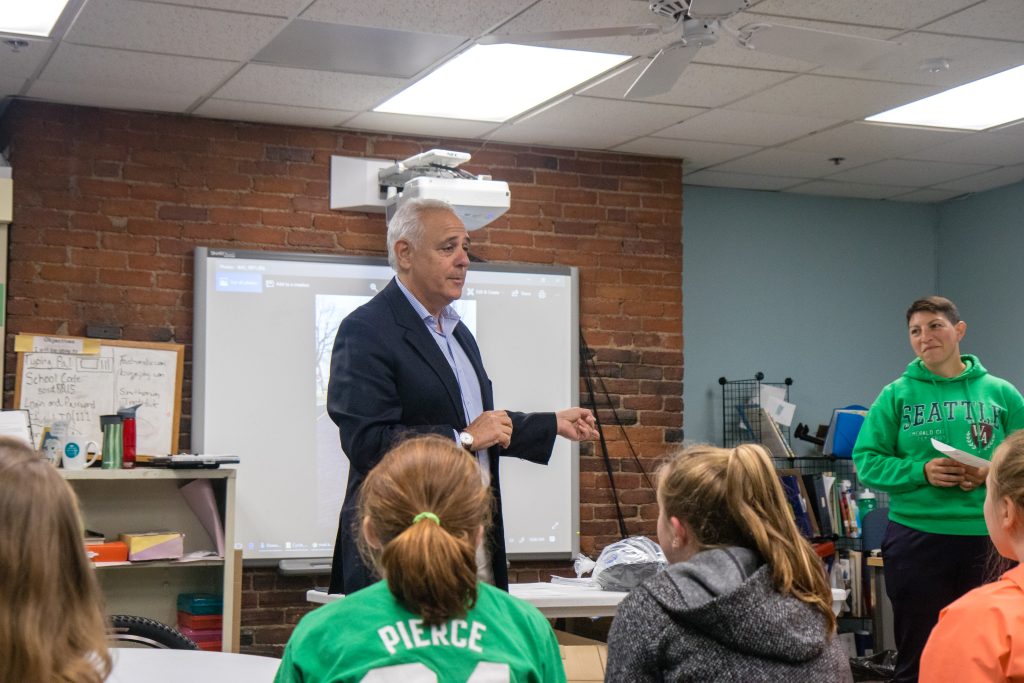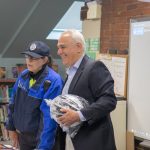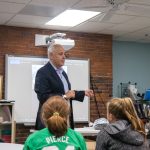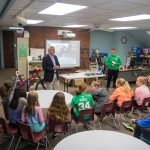Posts Tagged ‘“bicycle accidents”’
Driving Safely Near Cyclists During Boston’s Winter Pandemic
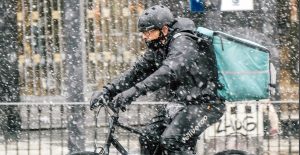
In Boston, drivers can take extra caution when traveling near a cyclist during winter.
Gone are the days when drivers only had to watch for cyclists during the warm weather in Massachusetts. Cyclists have become a fixture on our roads year-round in Boston, including in January and as the pandemic continues.
As a driver, we urge you to slow down this winter and look for cyclists. Also give cyclists extra room so they can respond to a traffic situation without wiping out or being struck in a bicycle accident.
While most cyclists try to avoid stormy weather, there are times when cyclists still find themselves riding in slippery or snowy situations. Also remember that days after a snow fall, snow plows can make another pass at roads and parking lots, which can interfere with a cyclist’s path as well as pedestrians, cars and delivery trucks.
If you fail to check for cyclists, you could cause a cyclist a life-threatening injury and be held financial liable by the victim. Do all you can to avoid causing a cycling accident. Take a few minutes to ask a cyclist about the challenges they face on the road, continuously check for cyclists while you drive and always assume there will be cyclists on the road.
This blog shares safety reminders to help Massachusetts drivers travel safely near cyclists this winter.
Massachusetts Bicycle Laws. In Massachusetts, cyclists have rights and responsibilities. One of the first rights concerns where cyclists can ride. Under M.G.L. c. 85, § 11B, cyclists are allowed to ride in a bike lane, on the side of the road or in the main traffic lane. Up to two cyclists can ride abreast in the main traffic lane. Cyclists should travel in the same direction as traffic.
When you see a cyclist, remember they can switch lanes or turn at any time. They may not always be able to safely use hand signals. Likewise, if you find yourself behind a bicycle and they are blocking traffic, you should practice patience or take another route.
Common Bicycle Injuries. Cyclists are vulnerable on the roads, traveling between motorized cars, trucks and other vehicles. A cyclist can be injured when a driver makes an error at an intersection or cuts the cyclist off when turning.
When a truck turns at an intersection, the driver has a responsibility to check for a cyclist before turning right. Truck drivers who neglect this step can cause a fatal crash injuring a cyclist. This is often called a “right hook” crash.
Another type of bicycle crash is called a “left hook” accident. This type of collision happens when a vehicle travels straight or turns left at an intersection, cutting off or colliding with a cyclist at an intersection. The cyclist is usually traveling in another direction.
By simply remembering to check for cyclists at intersections, truck drivers and motorists can make a big difference in preventing an accident or fatality. As you wait for a red light, try to look several times for cyclists: front, right, left and back. Many drivers neglect to fully check their blindspots, which is where cyclists are likely to be.
Darkness and Storms. The majority of fatal bike crashes in 2018 occurred between 6 p.m. and 9 p.m., according to the National Highway Traffic Safety Administration (NHTSA). Darkness falls earlier during the winter and there are also snow and rain conditions. Be patient if you see a cyclist pedaling in snow conditions.
As a driver, another step you can take is to look for well-lit roads. You can also look for the light. As a driver, if you see a flicker of color ahead, this is likely a cyclist or pedestrian.
Under Massachusetts law, cyclists are required to use bike lights when riding from thirty minutes after sunset until thirty minutes before. Bike reflectors are also required. Cyclists must have reflectors wrapped around both pedals or around their ankles. The bike lights should be visible from distances of 500 to 600 feet.
See the Cyclist From A Distance. In addition to checking for cyclists at intersections, always look ahead for cyclists. Scan the side of the roads. Cyclists should be traveling on the same side of the road as you in the same direction, but they may not always do so, especially if they are displaced by snow conditions. By taking time to look ahead, you give yourself more time to respond.
Read more tips on cycling safety in our article, “Facts About Massachusetts Bicycle Laws.”
About Breakstone, White & Gluck – Free Legal Consultation
Breakstone, White & Gluck has extensive experience representing cyclists who have been injured in bicycle accidents by negligent drivers in Boston, Cambridge and across Massachusetts. Our attorneys are skilled at investigation and negotiation with insurance companies to help our clients obtain the compensation they need for their recovery.
If you have been injured, learn your legal rights. Call Breakstone, White & Gluck at 800-379-1244 or 617-723-7676 for a free legal consultation. You can also use our online contact form.
Cyclists, Massachusetts is Still Celebrating Bay State Bike Month
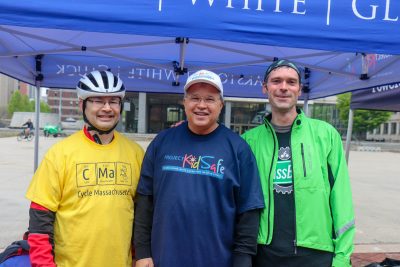
From 2019 Bike Month: Attorney David W. White (center) with Lee Toma (left) of Milton Bike and Galen Mook, executive director of MassBike.
Cyclists have something to look forward to this month. A long-time tradition will continue in Massachusetts: Bay State Bike Month. The schedule began on Sept. 1 and runs through the end of the month.
We encourage everyone who commutes to work to check out the schedule. Breakstone, White & Gluck usually participates in Bike Month activities in the Boston area and we have a lot of fun. We donate bicycle helmets to various events as part of our Project KidSafe campaign. Last year, Attorney David W. White was fitting helmets for commuters at Boston’s Bike to Work Festival at City Hall Plaza.
This is always a worthwhile opportunity to connect with other cyclists and learn about safe riding techniques. But we give cyclists a little more of a nudge this year, after so many of us have been isolated due to COVID-19.
Now in its 26th year, Bay State Bike Month is organized by MassBike, MassCommute and the Massachusetts Coalition of Transportation Management Associations. The goal is to promote cycling for commuting, fitness and recreation, and also introduce the activity to new riders. This year, the event was postponed from May to September due to COVID-19.
The schedule is lighter this year, but small and online events are being added daily. The signature event, MassCommute Bicycle Challenge, will still be held – though virtually – from Sept. 19 to 27. Get ready to log your miles.
While fewer cyclists may physically gather at events, we know many are interested in cycling and concerned about the risk for accidents. That’s why we want to share this video, “Safer Trucking in Changing Cities,” which was recently shared in the Somerville Bicycle Committee’s monthly newsletter. The video was funded by the Joe Lavins Fund for Bicycle Safety.
We encourage anyone interested in cycling on the road to watch this video and hear from local cyclists and safety advocates. They expertly describe safety conditions for cyclists in the Boston area and explain how truck drivers can reduce the risk for bicycle accidents. One topic was infrastructure. If you are new to cycling, it may be valuable to hear the cyclists explain some of the safety infrastructure cities have built in recent years. The cyclists explained how bike lanes, separated bike lanes and bike boxes at the top of intersections can protect cyclists – if truck drivers take the time to learn their responsibilities and give cyclists adequate space in these areas.
[vimeo 307147180 w=640 h=360]
SAFER TRUCKING in Changing Cities from FOV videos on Vimeo.
About Breakstone, White & Gluck – Boston Personal Injury Attorneys
Breakstone, White & Gluck is an award-winning Boston law firm which specializes in personal injury law. With more than 100 years combined experience, our firm has represented drivers, passengers, cyclists and pedestrians injured by negligent driving in Massachusetts.
We have made a special commitment to bicycle safety in Massachusetts. Each year, we donate bicycle helmets to children as part of our Project KidSafe campaign, working in partnership with local police departments, bicycle committees and Massachusetts Safe Routes to School.
We proudly support MassBike as a business member. Our attorneys also work with MassBike to distribute our bicycle helmets as part of our Project KidSafe campaign.
Massachusetts Safe Routes to School Recognizes Project KidSafe Bike Helmet Donation
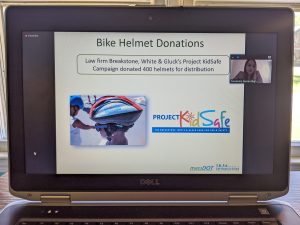
For the 6th year, Breakstone, White & Gluck and our Project KidSafe campaign are pleased to support Massachusetts Safe Routes to School. Once again, our attorneys have committed to donating 400 bicycle helmets to Safe Routes. From there, the Safe Routes coordinators will give the helmets to low-income children who want to participate in bike safety training and bike rodeos.
This morning, Massachusetts Safe Routes to School held its annual awards ceremony to honor schools and teachers which have excelled in reaching their walking and biking goals for children. Stephanie Pollack, secretary and CEO of the Massachusetts Department of Transportation (MassDOT), was the featured speaker. Before announcing the awards, Massachusetts Safe Routes to School thanked Breakstone, White & Gluck for our donation.
This is Massachusetts Safe Routes to School’s 15th anniversary. For those who don’t know, Massachusetts Safe Routes to School is a federally funded initiative of the MassDOT. Over 15 years, it has offered biking and pedestrian safety program to children in 237 communities and reached more than 420,000 students. Schools are committed to the programming. Safe Routes now has 920 partner schools. View this year’s awards list.
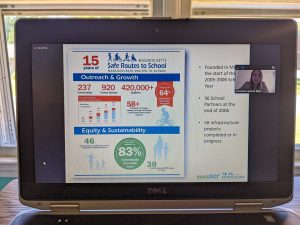 About Breakstone, White & Gluck – Commitment to Bike Safety
About Breakstone, White & Gluck – Commitment to Bike Safety
The Boston personal injury lawyers at Breakstone, White & Gluck are committed to safety and preventing head injuries. Through our Project KidSafe campaign, we have donated 30,000 children’s bicycle helmets across Massachusetts. We founded our campaign in 2013 and have since partnered with Massachusetts Safe Routes to School, local police departments, bicycle committees and community groups. Our goal has been to work with community partners who really care and are committed to bicycle safety and preventing head injuries.
In Massachusetts, cyclists under age 17 must wear bicycle helmets. But every cyclist is encouraged to wear a helmet. We hope you are never injured on a bike, but you can recover from many injuries. Head injuries can be fatal and it is important to protect yourself.
Commit to wear a bicycle helmet every time you ride. Helmet use has been estimated to reduce the chances of head injury by 50 percent and the chances of head, face or neck injury by 33 percent, according to the Insurance Institute for Highway Safety.
Attorney Ron Gluck Writes: “Underinsured Motorist Coverage: Protect Yourself and Your Family”
Attorney Ron Gluck recently authored an article, “Underinsured Motorist Coverage: Protect Yourself and Your Family,” which was published in the Charles River Wheelers newsletter, WheelPeople. He writes that readers may be surprised to learn this coverage can protect every member of their household when driving, riding as a passenger or even outside a vehicle, when cycling, walking or going for a jog. But there are a few essentials to understand before you buy.
Learn more about Attorney Ron Gluck.
Encouraging Boston Drivers to Look For Cyclists
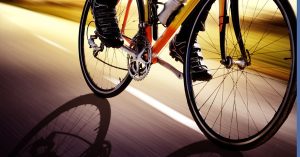
Safety reminders for drivers as cyclists return to the road in Boston.
In Boston, many cyclists take a winter break. As this nears an end, drivers should get ready to commute alongside cyclists again. Everyone should be aware of the risks for bicycle accidents at intersections. These include right hook accidents, which occur when a driver fails to yield to a cyclist while turning right.
Drivers must remember that cyclists have the same rights and responsibilities as drivers. Here, we share a few safety tips for drivers from the National Highway Traffic Safety Administration (NHTSA):
- Obey the speed limit.
- Drive defensively. Cyclists may need to leave their lane for safety reasons and may not give you much notice.
- Yield to cyclists just as you would another motor vehicle.
- When turning right on a red light, check for cyclists to the right and behind you. Stop completely and look in both directions – left, right, left and behind.
- Provide cyclists with adequate space.
- Pass cyclists with care. Do not pass too closely and only do so if you would pass a motor vehicle in the same situation.
- Check before you pull out or back up in parking lots.
- Check for cyclists when at stop signs. Expect that a cyclist may come up behind you while you wait for your turn to go.
Driving Safely Near Bicyclists in Massachusetts
Gone are the days when drivers rarely saw a cyclist on the road. It’s critical for drivers to be informed about their responsibilities near cyclists, particularly in intersections, and the potential for bicycle crashes.
As a driver, if you are near a bicyclist, the best approach is to slow down and give them room. Do not take your eyes off the cyclist or the road. If you don’t see a cyclist, take the opportunity to look.
Leave the bicycle lane for cyclists – this is the law in Massachusetts and if you neglect to follow it, you could hit a cyclist, causing serious injury and confusing other drivers. And this could lead to domino-effect collisions with other vehicles, cyclists or pedestrians in the area.
Expect cyclists will be traveling in front of you, as well as behind you. In fact, they are more likely to be behind you, to the right (though they are allowed to travel in the center of the lane in Massachusetts if they need to). Checking your mirrors is essential, as is left-right-left and behind checking. This is true even after you park because cyclists could be riding by and by opening the door at the wrong time, you could cause a bicycle dooring injury.
Finally, remember cyclists may not be visible behind commercial trucks and other traffic. The cyclist may be out of your view, but just approaching the large vehicle behind you. If the vehicle behind you is obstructing your view, take an extra few seconds.
For more information, read our articles, “Facts About Bicycling Laws in Massachusetts,” or “Tips for Safe Bike Commuting in Boston.” You can also visit the MassBike website, which explains more about cyclist and motorist responsibilities or the NHTSA web page on bicycle safety.
Free Legal Consultation – Boston Bicycle Accident Attorneys
Breakstone, White & Gluck has extensive experience handling personal injury cases involving bicycle injuries in Boston and across Massachusetts. After a bicycle accident, our attorneys are here to provide clients with thorough investigation and aggressive representation. We understand the stakes are high when you have been injured on a bicycle because medical bills can mount quickly and no one expects to suffer an injury. But we have attorneys who are experienced as lawyers and as cyclists. We are committed to partnering with our clients to obtain the best financial result in every case.
For a free legal consultation, contact Breakstone, White & Gluck at 800-379-1244 or 617-723-7676. You can also use our contact form.
How to Fit a Bicycle Helmet
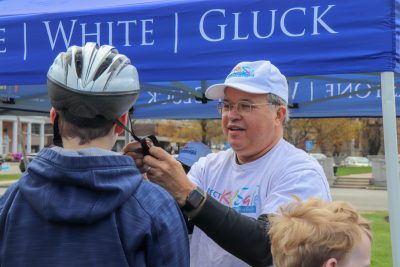
Attorney David W. White fitting helmets at Framingham Earth Day 2019. Part of Breakstone, White & Gluck’s Project KidSafe campaign to prevent head injuries.
While many people enjoy cycling, very few enjoy the process of selecting and fitting a bicycle helmet. The challenge is even greater for parents who have to find helmets for their children.
Breakstone, White & Gluck launched our Project KidSafe campaign in 2013 to help children and families, along with other cyclists, overcome some of the challenges. Read some of our tips for getting started with a bicycle helmet which fits and protects:
- Before you shop, find a flexible tape measure and measure around your head. Measure from about an inch above your eyebrows.
- Rather than shopping online, try to purchase a helmet at a local bicycle shop. Ask the staff to help you fit it properly.
- Before you purchase, ask if the helmet meets the safety standards set by the Consumer Product Safety Commission.
- Don’t share bicycle helmets. Each cyclist should have their own helmet.
- Store your helmet inside and avoid exposing it to heat in sunlight unless you are wearing it. Don’t leave it in your car for any extended period.
- Replace bicycle helmets when they become worn or if you or your child outgrow yours. You may want to consider buying a new helmet every three years. From the outside, your helmet may appear to be in good condition. Yet the protective material inside can deteriorate without any visible signs.
- Immediately replace bicycle helmets which hit the ground in a bicycle accident or fall.
- Carry your bicycle helmet if you want to use a bikeshare. Make it a rule not to rent a bike without a helmet.
- Plan ahead: Keep an extra bicycle helmet at work or at home.
- Remember, parents who wear helmets encourage children to wear helmets.
- Take children to bicycle safety events in the community to encourage their interest in cycling and safety.
About Breakstone, White & Gluck
Breakstone, White & Gluck is a Boston personal injury law firm which represents those injured by the negligence and wrongdoing of others across Massachusetts. After more than two decades of representing cyclists who have been injured, the firm’s partners launched the Project KidSafe campaign to help prevent injuries on bikes and encourage children to wear helmets throughout their lives. The firm specializes in all areas of personal injury law.
Learn more about our attorneys.
Learn more about the Project KidSafe campaign.
Watch a video demonstrating how to fit a bicycle helmet.
Massachusetts Drivers: Start Spring by Learning the Dutch Reach Method
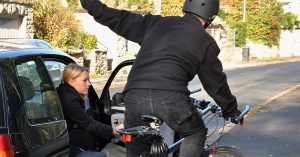
A passenger nearly causes a dooring accident by opening her car door, without checking for cyclists. By using the Dutch Reach method, drivers and passengers can reduce their risk of causing these injuries.
As April begins, so come more cyclists on the road. Drivers should consider each cyclist a reminder to use the Dutch Reach method and never open your car door without checking. You can cause serious and even fatal injuries to a cyclist. In Massachusetts, you may also be held financially responsible for the tragedy that follows.
At Breakstone, White & Gluck, our lawyers have represented many cyclists injured by dooring accidents and other bicycle collisions in Boston, Cambridge and across the state. We urge drivers to take a few minutes to learn about the Dutch Reach method to prevent injuries.
Lack of awareness causes many injuries. Many drivers park and open their car door automatically, heedless of its risk to passing cyclists or to themselves (or door!) even as the number of cyclists sharing our roads increases by the year. In Boston alone, the city’s bike counting program tracked nearly 40,000 bike trips each day in 2017. During 2019, the concern spreads beyond cyclists as dockless scooters arrive in the Boston area.
What is the Dutch Reach?
Dooring accidents happen after drivers park and exit their vehicles without checking. The Dutch Reach method attempts to slow the process down and give drivers more time to see cyclists and anticipate potential accidents.
The approach calls on drivers to park and then check their rear-view and side-view mirrors. If there are no cyclists or pedestrians nearby, drivers can turn to open the door with their far hand. In the process, they should get a good look at the road behind them. Both drivers and passengers are advised to follow this approach. By doing so, drivers can limit the risk for injuries to cyclists as well as pedestrians.
Watch this video to learn about the Dutch Reach method. The demonstration begins around the 1 minute mark.
https://youtu.be/ppBuWxvypfg
The Dutch Reach method originated in the Netherlands. But Michael Charney, a Cambridge doctor, began campaigning for awareness in Massachusetts in 2016, after the devastating bicycle crash which killed Amanda Phillips in Cambridge’s Inman Square. The 27-year-old was hit by two vehicles, first an open door.
As a result of this campaign, Massachusetts updated its state driver’s manual in 2017, adding instructions for the Dutch Reach method. Dooring has been against the law in Massachusetts since 2009. You can be cited and fined up to $100 per offense for interfering with other traffic, including a pedestrian or cyclist. You can also face a civil claim from the victim seeking financial damages. For years, drivers and cyclists have learned the dangers of dooring crashes after a collision; but adding the Dutch Reach instructions to the Massachusetts driver’s manual now provides clear and concise instructions for how to prevent these crashes.
Following success in Massachusetts, Charney’s campaign has continued, resulting in two other states, Washington and Illinois, adding the Dutch Reach to the state driver’s manual.
Safety Reminders for Traveling Near Cyclists
- Expect cyclists on the road. Many cyclists will travel in the bike lane or to the right of traffic, but remember that cyclists have the legal right to operate in the traffic lane when they need.
- Slow down. When you travel fast, you have less time to respond.
- Follow cyclists at a safe distance. Cyclists should have at least three feet of space when you pass them.
- The further back you travel, the wider your field of vision.
- Remember that cyclists may need to leave the bike lane. You need to make sure you can respond if they do.
- Expect someone may stop unexpectedly, such as a delivery truck or an Uber or Lyft vehicle picking up a passenger.
- Be careful not to startle a cyclist. Never honk.
- Approach crosswalks and traffic signals with caution. Cyclists are supposed to stop, but expect there may be times they can’t due to traffic conditions.
- Use your mirrors. Check for cyclists behind you and next to you, especially before turning or parking.
- Finally, again, be careful when parking. Use the Dutch Reach method. Be cautious when parking in unfamiliar streets and avoid parking near traffic signals and crosswalks.
About Breakstone, White & Gluck
The Boston personal injury lawyers at Breakstone, White & Gluck represent cyclists who have been injured by the negligence of drivers. We also work to prevent bicycle accidents and improve safety through our sponsorship of bicycle clubs in the Boston area and our Project KidSafe campaign, which has donated more than 25,000 bicycle helmets to children across Massachusetts.
If you have been injured, Breakstone, White & Gluck offers a free legal consultation. Learn more about our attorneys.
For the 5th Year, Breakstone, White & Gluck Donates Children’s Bicycle Helmets in Westborough
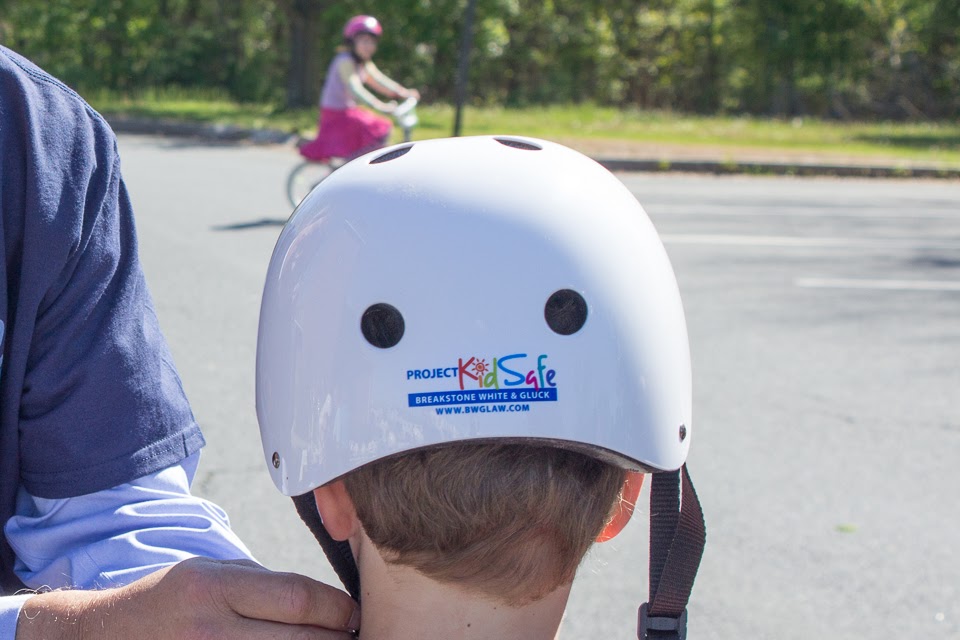
Breakstone, White & Gluck’s Project KidSafe campaign donated nearly 200 youth bicycle helmets in Westborough this year. Our attorneys are committed to preventing head injuries and for 5 years, have partnered with the Westborough Bicycle & Pedestrian Advisory Committee to bring helmets to children who need one. (File photo: From a May 2016 Project KidSafe event in Western Mass).
We are glad the weather held off!
For the fifth year, Breakstone, White & Gluck and our Project KidSafe campaign donated nearly 200 children’s bicycle helmets in Westborough. Last Spring, about 100 helmets were distributed by the Boroughs Family Branch of the YMCA of Central Massachusetts. The helmets went to children who needed one at the annual Healthy Kids Day. But thanks to Mother Nature, giving away the rest was more challenging.
First, unseasonable weather forced the the Rotary Club of Westborough to cancel the Spring Fest. On Saturday, it looked like the back-up plan – to hold a Fall Fest – was also in jeopardy. But we are happy to report the skies cleared enough for activities to go on. Our thanks to members of the Westborough Bicycle & Pedestrian Advisory Committee, who were out fitting our Project KidSafe helmets for the kids and talking to families about the importance of wearing them.
Wearing a helmet is critical for cyclists of any age. A helmet can limit the impact if a cyclist falls and significantly reduce the chances of a head injury. In Massachusetts, cyclists under 17 are required to wear helmets when they ride. The Boston personal injury lawyers at Breakstone, White & Gluck began our Project KidSafe campaign to put helmets on more children and to encourage children and families to wear one at all times. Our lawyers have represented many cyclists who have suffered head injuries in bicycle accidents over the years, and we know that cyclists can protect themselves by wearing a helmet, which is in good condition, meets safety standards set by the Consumer Product Safety Commission and properly fits.
That’s why Breakstone, White & Gluck founded our Project KidSafe campaign in 2013. As we near the end of 2018, our attorneys are proud to have donated over 20,000 bicycle helmets across Massachusetts. We have partnered with more than 40 organizations over the years and it’s one of our priorities to support local bicycle committees, which are making Massachusetts safer one project at a time. In Westborough, the committee has worked to improve pedestrian and bike signals and supported construction of bike paths. The Westborough Bicycle & Pedestrian Advisory Committee’s website provides resources for cyclists who want help getting around.
Read about the Westborough rotary’s Fall Fest in the Community Advocate newspaper.
Dooring Crashes Continue to Endanger Cyclists in Boston, Cambridge and Other Cities
 A recent New York Times article on dooring injuries shows the risks to cyclists continue, even after advocacy efforts in Boston and other cities.
A recent New York Times article on dooring injuries shows the risks to cyclists continue, even after advocacy efforts in Boston and other cities.
At Breakstone, White & Gluck, our attorneys represent cyclists who have been seriously injured in dooring accidents. While many dooring accidents happen in urban areas such as Boston, Cambridge and Somerville, dooring can happen in any community in Massachusetts. When drivers or passengers open doors without checking, cyclists can suffer devastating injuries, including broken bones, facial fractures and head injuries. Dooring crashes can be fatal.
Dooring crashes do not always make the news in Boston. But they are happening, more than any other type of bicycle accident. In fact, in November 2016, The Boston Globe reported cyclists faced a 225 percent higher risk for dooring than any other bicycle accident injury.
The Dutch Reach Moving Across the U.S.
The New York Times published, “The Dutch Reach: a No-Tech Way to Save Bicyclists’ Lives,” earlier this month. The Dutch Reach takes its name from the Netherlands, where there is a strong culture of safety for cyclists and drivers are taught to closely watch for bikes.
The New York Times interviewed Michael Charney, the Cambridge doctor who campaigned for greater use of the “Dutch Reach” method following the 2016 death of a cyclist in Inman Square. The 27-year-old woman was killed in a dooring crash. Charney’s campaign led the state of Massachusetts to add the “Dutch Reach” method to the state’s driver’s manual in 2017.
According to the article, Massachusetts and Illinois are now the only two states which have added “Dutch Reach” to the drivers’ manuals. Read the page from the Massachusetts driver’s manual.
Drivers can commit to drive safer and reduce the number of dooring crashes, according to those interviewed. Watch a video to learn the Dutch Reach method. Keep a colored ribbon or other reminder in your vehicle to help you check.
The Dutch have a great deal of education for drivers. Students actually start learning about road safety at age 10, then move to bikes before getting in a motor vehicle. Drivers typically spend about $2,700 for driver’s instruction, sitting for nearly 40 hours of instruction.
While you may not sign up for driver’s ed again. But remember that there is education online to help you. Groups such as AAA, AARP or the National Safety Council offer materials to help you avoid collisions. The League of American Bicyclists also offers materials and Bicycle Friendly Driver Training.
Here at Breakstone, White & Gluck, we also want to remind you to put down your cell phone and other distractions. With cyclists and other pedestrians around, it is not safe to reach for your cell phone as soon as you turn off the engine and just step outside without looking. Wait until you step onto the sidewalk and are out of the path of cyclists.
Injured? Free Legal Consultation for Cyclists: 800-379-1244
Breakstone, White & Gluck and our Boston personal injury lawyers specialize in bicycle accident cases. If you have been injured in a dooring accident, our experienced lawyers can represent your best interests, helping you obtain the medical treatment you need and investigating what happened to help ensure the driver is properly cited. For a free legal consultation, contact us at 800-379-1244 or 617-723-7676 or use our contact form.
Our Law Firm’s Commitment to Bicycle Safety for Somerville 5th Graders and Somerville Public Schools
For the fifth year, Somerville 5th graders have met our challenge. Our lawyers are pleased to send 370 students into summer with a free bicycle helmet from Project KidSafe, our campaign to encourage safe cycling and prevent head injuries.
The students earned the helmets by completing the CYCLE Kids curriculum, which teaches bicycle safety fundamentals. CYCLE Kids is offered as part of physical education classes at Somerville public schools. Through CYCLE Kids, some students in Somerville learn how to ride a bicycle for the first time. Others gain valuable experience or take other cycling firsts – such as riding with friends for the first time or their first ride on the Somerville Community Path.
“It’s all about your brain. Your brain is going to take you through life,” Attorney Ron Gluck told 5th graders at the Benjamin G. Brown School on Monday. “So protect your brain and it’s our pleasure to give you these helmets. You earned them, through your good work in learning about safety and bicycles.”
“It’s all about safety, but it’s also the law,” Somerville Police Officer Marianne Manfra added. In Massachusetts, cyclists who are 16 years old and younger are required to wear helmets. We urge all cyclists to wear helmets.
Shawn Maguire, principal of the Benjamin G. Brown School, Sharyn Von Trapp, the 5th grade physical education teacher and Steve Simolaris, supervisor of health and physical education at the Somerville public schools, all attended the gathering to recognize students for completing CYCLE Kids. Von Trapp handed students certificates of completion, while Attorney Gluck and Officer Manfra gave students their helmets (and we are pleased to report the students already knew how to fit their own helmets and some knew enough to help friends).
About Breakstone, White & Gluck and Project KidSafe
Attorneys Marc L. Breakstone, David W. White and Ronald E. Gluck founded our law firm in 1992. Breakstone, White & Gluck is a personal injury law firm and as part of our practice, our attorneys have long represented cyclists. We know wearing a bicycle helmet can make every difference in preventing head injuries and saving lives. Wearing a helmet is also a simple step anyone can take. We founded our Project KidSafe campaign in 2013 to encourage helmet use.
Over six years, our attorneys have given away more than 20,000 bicycle helmets to children in Massachusetts. Each year, we partner with CYCLE Kids and Somerville public schools, along with the Kiwanis Club of Somerville on its annual Bicycle Safety Day. One hundred cyclists turned out this year to learn cycling skills. The event was held last weekend at the East Somerville Community School.
We also partner with Groundwork Somerville, which gives our helmets to students who participate in summer programming and rely on their bikes for transportation throughout the day.
About Breakstone, White & Gluck
The Boston personal injury lawyers of Breakstone, White & Gluck have over 100 years combined experience representing those who have been injured by the negligence or wrongdoing of others. To learn more about our attorneys, visit our website. For a free legal consultation, contact us at 800-379-1244 or 617-723-7676 or use our contact form.


